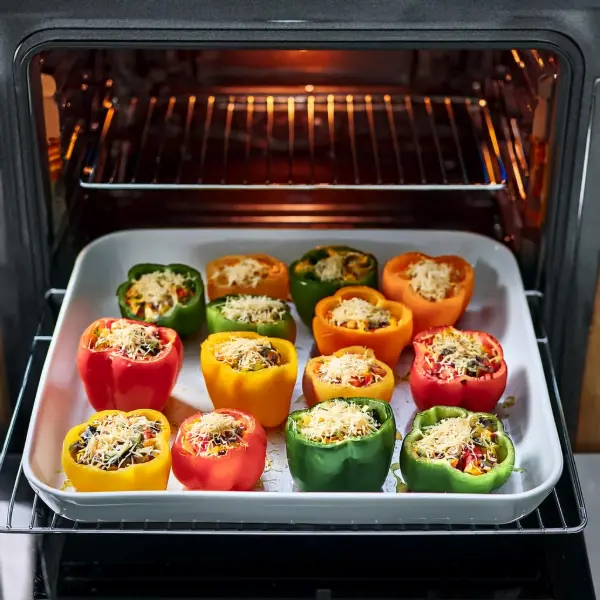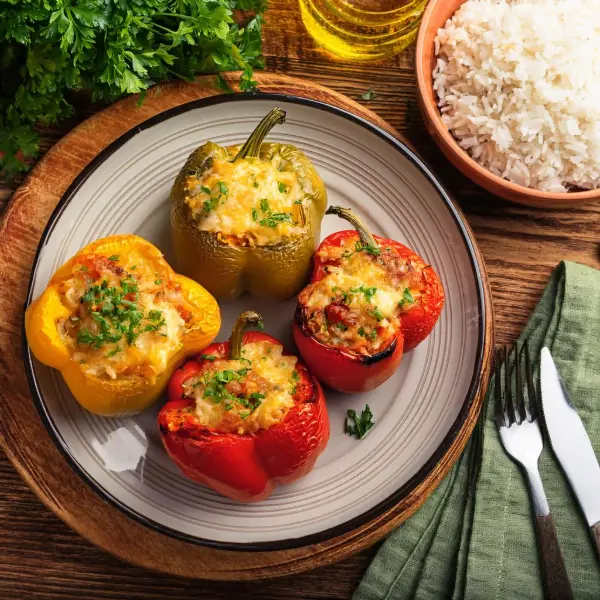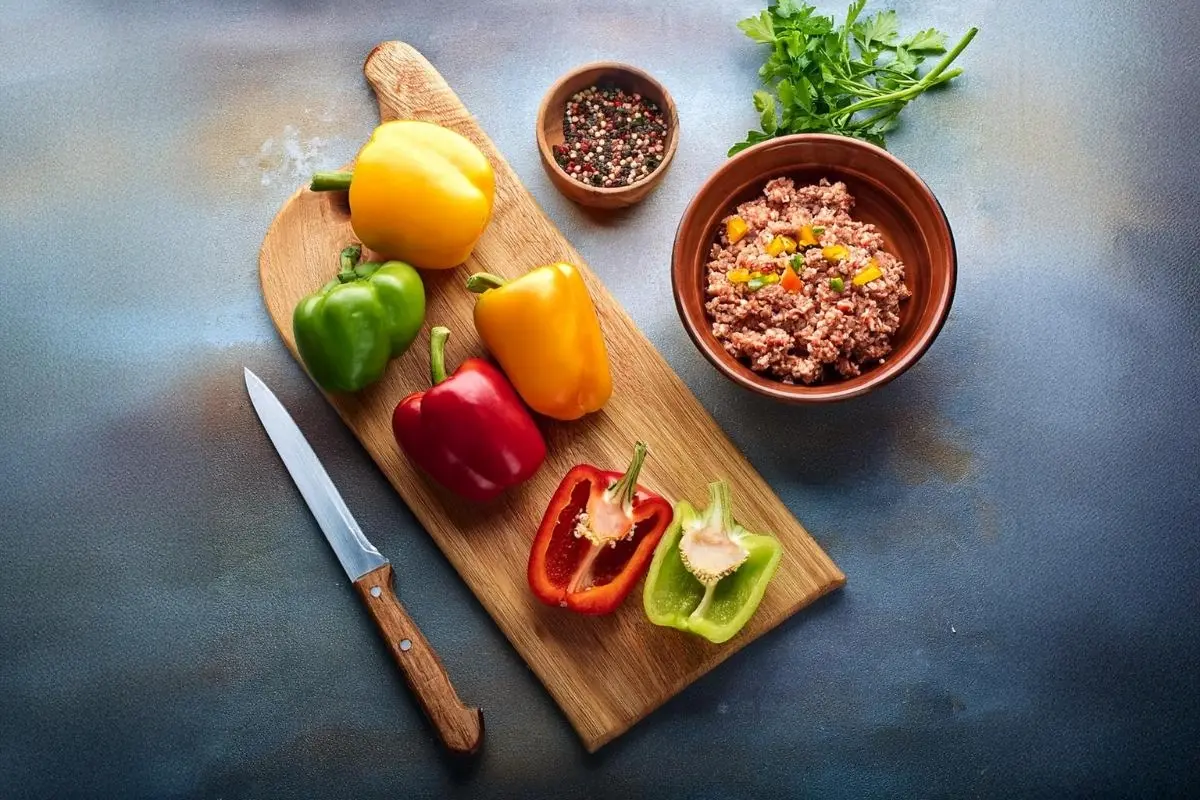Introduction :
Stuffed peppers are a classic dish that many people love for their versatility and delicious flavors. However, one of the most frustrating problems home cooks encounter is watery stuffed peppers. If you’ve ever taken your dish out of the oven only to find a pool of liquid at the bottom, you’re certainly not alone! This issue can affect both the texture and taste, making what should be a hearty, satisfying meal turn into a soggy disappointment. Fortunately, learning how to avoid watery stuffed peppers is simpler than you might think. In this article, we’ll explore the causes of watery stuffed peppers, discuss practical tips to prevent them, and provide a detailed, step-by-step recipe that will help you achieve perfectly cooked peppers every time.
Whether you’re new to making stuffed peppers or you’ve faced challenges with them in the past, following these techniques will ensure that your dish is firm, flavorful, and free of unwanted moisture. Stick with us as we uncover the secrets to mastering stuffed peppers and say goodbye to soggy results for good!
Why Do Stuffed Peppers Become Watery?
Common Causes of Watery Stuffed Peppers
Understanding how to avoid watery stuffed peppers is the first step to preventing a disappointing, soggy dish. There are several reasons stuffed peppers become watery, and knowing these causes will help you make the necessary adjustments to your cooking process for better results.
One of the primary causes of watery stuffed peppers is the excess moisture in the peppers themselves. Peppers naturally contain a lot of water, which is released during cooking. If this moisture isn’t managed properly, it can pool at the bottom of your baking dish, resulting in soggy stuffed peppers that lack the desired firm texture.
Additionally, using high-moisture ingredients in the filling can make the problem worse. Ingredients like fresh tomatoes, zucchini, or uncooked rice tend to release water as they cook, increasing the chances of ending up with watery stuffed peppers. To prevent this, it’s important to drain vegetables and meat thoroughly before adding them to the filling and to use absorbent ingredients like cooked rice, breadcrumbs, or quinoa.
By addressing these causes, you can take the right steps to avoid watery stuffed peppers and enjoy a perfectly cooked dish every time!
Impact of Watery Stuffed Peppers on Taste and Texture
The impact of watery stuffed peppers goes beyond aesthetics. Not only does excess water make the dish visually unappealing, but it also affects the overall taste and texture.
First, a watery dish dilutes the flavors of your filling. The rich, savory taste of the filling can get washed out if there’s too much moisture. Moreover, the texture of the filling becomes mushy instead of hearty and satisfying.
Additionally, watery peppers can make the overall presentation of the dish less appetizing. Instead of beautifully baked peppers with a golden, crispy top, you end up with limp, soggy peppers sitting in a pool of liquid.
Key Mistakes That Lead to Watery Stuffed Peppers
Several common mistakes can lead to watery stuffed peppers. Here’s a quick rundown of what to avoid:
- Not pre-cooking the peppers: Raw peppers release more water during baking.
- Using uncooked filling ingredients: Uncooked rice, vegetables, or meat can release excess moisture.
- Overcrowding the baking dish: When peppers are packed too tightly, they steam instead of roast.
- Skipping the rest period after baking: Not allowing the peppers to rest can cause juices to pool on your plate.
Tips to Prevent Watery Stuffed Peppers
If you’ve been struggling with watery stuffed peppers, don’t worry—there are several easy ways to prevent this common problem. By following a few key tips, you can ensure your stuffed peppers turn out firm, flavorful, and perfectly cooked every time. Let’s explore these practical techniques to avoid excess moisture and achieve the best results.
Pre-Cook Your Peppers to Reduce Moisture
One of the most effective ways to avoid watery stuffed peppers is to pre-cook the peppers before stuffing them. This simple step helps remove some of the natural moisture in the peppers, preventing it from pooling at the bottom of your dish during baking.
Methods for Pre-Cooking Peppers
There are two common methods for pre-cooking your peppers:
- Parboiling: Boil the peppers for 5 minutes in salted water, then drain and let them cool. This method softens the peppers slightly and reduces their water content.
- Pre-Baking: Place the cleaned peppers in a baking dish and bake them at 375°F (190°C) for 10-15 minutes before adding the filling. This method works well if you prefer a roasted flavor.
Both methods help reduce the risk of watery peppers by removing excess moisture upfront.
Use Absorbent Ingredients in the Filling
Another important tip is to use absorbent ingredients in your filling. When cooking stuffed peppers, the filling can release moisture as it cooks, which contributes to the problem. Using absorbent components can help soak up any excess liquid.
Best Absorbent Ingredients to Use
Here are a few absorbent ingredients to consider:
- Cooked Rice: Using fully cooked rice instead of uncooked rice helps absorb moisture from the filling.
- Quinoa: Quinoa is another great option because it holds up well during baking and absorbs liquid effectively.
- Breadcrumbs: Adding a small amount of breadcrumbs to your filling can help soak up any extra moisture.
Quick Tip: Avoid using high-moisture vegetables like fresh tomatoes or zucchini in your filling unless you sauté them beforehand to remove excess water.
Drain Vegetables and Meats Thoroughly
If your filling includes vegetables or ground meat, it’s essential to drain them thoroughly before stuffing the peppers.
How to Properly Drain Filling Ingredients
- Vegetables: Sauté vegetables like onions, mushrooms, or spinach before adding them to the filling. This helps release their moisture.
- Meat: If you’re using ground beef, turkey, or sausage, cook it first and drain any excess grease or liquid. This prevents the filling from becoming too wet.
Avoid Overcrowding the Baking Dish
Overcrowding the baking dish can cause the peppers to steam rather than roast. This steaming effect traps moisture, making your peppers soggy.
Solution:
Arrange the peppers in a single layer with enough space between them to allow air circulation. This helps them roast evenly and reduces moisture buildup.
Proper Baking Techniques to Prevent Watery Stuffed Peppers
Even if you use the right ingredients and pre-cook your peppers, poor baking techniques can still result in watery stuffed peppers. The way you bake your peppers matters a lot, from oven temperature to baking time and covering the dish. Let’s dive into some essential baking tips to help you achieve perfectly roasted, firm, and flavorful stuffed peppers.
Choose the Right Oven Temperature
One of the key factors in avoiding watery stuffed peppers is using the right oven temperature. Baking at a temperature that’s too low can cause the peppers to steam rather than roast, leading to excess moisture pooling in the dish.
Best Oven Temperature for Stuffed Peppers
The ideal oven temperature for baking stuffed peppers is 350°F to 375°F (175°C to 190°C). This temperature is high enough to roast the peppers and allow the filling to cook through without making them soggy.
- Whole Peppers: Bake at 375°F for 30-35 minutes.
- Halved Peppers: Bake at 350°F for 20-25 minutes.
Baking at this range ensures the peppers are tender and the filling is cooked without excess moisture.
Cover the Peppers with Foil During Baking
Another critical step in preventing watery stuffed peppers is to cover the dish with aluminum foil during the first half of the baking process. Covering the dish helps trap steam, allowing the filling to cook evenly without drying out.
However, leaving the foil on for too long can cause moisture to build up. Therefore, it’s essential to remove the foil toward the end of baking to let the moisture evaporate and the tops of the peppers brown nicely.
How to Properly Cover and Uncover Stuffed Peppers
- Cover the Baking Dish: Use aluminum foil to cover the dish during the first 20-25 minutes of baking.
- Uncover the Dish: Remove the foil for the last 10-15 minutes to allow excess moisture to escape and to brown the cheese topping if used.
Allow the Peppers to Rest After Baking
Once your stuffed peppers are done baking, it’s crucial to let them rest for a few minutes before serving. This resting period allows the juices to redistribute and settle, preventing them from spilling out onto the plate.
Why Resting Time Matters
- Reduces Moisture: Letting the peppers rest for 5-10 minutes helps reduce the amount of liquid that pools at the bottom of the dish.
- Enhances Flavor: Resting also allows the flavors in the filling to meld, making each bite more delicious.
Use a Baking Rack for Better Airflow
If you want to take your baking technique to the next level, consider using a baking rack. Placing your stuffed peppers on a wire rack inside the baking dish allows better airflow, which helps reduce moisture buildup.
Quick Tip: Line the bottom of your baking dish with parchment paper to catch any drips, making cleanup easier.
Recipe for Perfectly Stuffed Peppers
To truly avoid watery stuffed peppers, it’s important to follow a well-crafted recipe that incorporates the tips we’ve discussed so far. Below is a detailed recipe that covers everything—from pre-cooking the peppers to using the right filling ingredients—to ensure your stuffed peppers turn out firm, flavorful, and delicious.
Ingredients for Perfectly Stuffed Peppers
Here’s what you’ll need to make a batch of stuffed peppers that are both hearty and free of excess moisture:
- 4 large bell peppers (any color)
- 1 pound ground beef or turkey
- 1 cup cooked rice or quinoa
- 1 small onion, diced
- 2 cloves garlic, minced
- 1 cup diced tomatoes (drained)
- ½ cup shredded mozzarella or cheddar cheese
- 1 tablespoon olive oil
- 1 teaspoon salt
- ½ teaspoon black pepper
- 1 teaspoon Italian seasoning
Optional Ingredients:
- ¼ cup breadcrumbs (for absorbing extra moisture)
- ½ cup spinach, sautéed and drained
Step-by-Step Instructions for Making Stuffed Peppers
Step 1 – Pre-Cook the Peppers
- Preheat your oven to 375°F (190°C).
- Slice the tops off the bell peppers and remove the seeds and membranes.
- Place the peppers in a baking dish, standing upright.
- Bake the peppers for 10-15 minutes to reduce their moisture content. Alternatively, you can parboil them in salted water for 5 minutes.
Step2 – Prepare the Filling
- In a large skillet, heat 1 tablespoon of olive oil over medium heat.
- Add the diced onion and sauté for 3-4 minutes until softened.
- Stir in the minced garlic and cook for an additional 1 minute.
- Add the ground beef or turkey, cooking until browned and fully cooked.
- Drain any excess grease from the skillet to avoid adding extra moisture to the filling.
- Mix in the cooked rice or quinoa, diced tomatoes, salt, pepper, and Italian seasoning.
- If using breadcrumbs or spinach, add them at this stage to absorb any remaining liquid.
Step3 – Stuff the Peppers
- Once the peppers have been pre-cooked, remove them from the oven and let them cool slightly.
- Spoon the prepared filling mixture into each pepper, pressing gently to pack the filling tightly.
- Top each stuffed pepper with shredded cheese for a golden, crispy finish.
Step4 – Bake the Stuffed Peppers
- Cover the baking dish with aluminum foil and bake at 375°F (190°C) for 25-30 minutes.
- Remove the foil during the last 10-15 minutes of baking to allow the cheese to brown and the peppers to crisp up slightly.
Step5 – Let the Peppers Rest
- After removing the dish from the oven, let the peppers rest for 5-10 minutes before serving. This step is crucial for preventing excess moisture from pooling on the plate.
Quick Serving Tip
- Serve your stuffed peppers with a side of quinoa salad or garlic bread for a complete meal.
- Garnish with fresh herbs like parsley or basil for added flavor and presentation.
Nutritional Content of Stuffed Peppers (Per 100g)
| Nutrient | Amount | % Daily Value |
|---|---|---|
| Calories | 180 kcal | 9% |
| Protein | 12g | 24% |
| Total Fat | 8g | 12% |
| Carbohydrates | 15g | 5% |
| Fiber | 3g | 12% |
| Vitamin C | 60% | – |
| Calcium | 10% |
Nutritional Benefits and Variations for Stuffed Peppers

Stuffed peppers are not only delicious but also packed with essential nutrients. By choosing the right ingredients, you can turn this dish into a well-balanced, healthy meal that suits various dietary preferences. Let’s explore the nutritional benefits of stuffed peppers and some creative variations to keep your meals exciting.
Nutritional Benefits of Stuffed Peppers
Stuffed peppers provide a wide range of vitamins, minerals, and macronutrients that contribute to a healthy diet. Whether you use meat-based or plant-based fillings, stuffed peppers are a great way to pack a lot of nutrients into one dish.
Rich in Vitamins and Antioxidants
Peppers, especially red and yellow varieties, are loaded with vitamins and antioxidants. They are an excellent source of vitamin C, which helps boost your immune system and promote healthy skin. Additionally, they contain vitamin A, which supports eye health.
- Red bell peppers have more vitamin C than oranges.
- Yellow peppers are high in carotenoids, which have antioxidant properties.
Cooking the peppers doesn’t significantly reduce their nutrient content, making them a healthy choice even after roasting.
High in Fiber
Stuffed peppers are also a great source of dietary fiber, especially when filled with whole grains like quinoa or brown rice. Fiber is essential for digestive health, promoting regular bowel movements and helping you feel fuller for longer.
Protein-Packed Fillings
The filling you choose can make your stuffed peppers a high-protein meal. Using ground beef, turkey, or chicken provides a substantial amount of protein, which is important for muscle repair and overall health. For vegetarians, options like black beans, lentils, or chickpeas are great protein-packed alternatives.
Variations to Customize Your Stuffed Peppers
One of the best things about stuffed peppers is their versatility. You can easily customize the fillings to suit your taste preferences, dietary restrictions, or even the ingredients you have on hand.
Vegetarian and Vegan Options
For a meat-free option, swap out the ground meat for black beans, quinoa, or lentils. You can also add vegetables like spinach, mushrooms, and zucchini to create a hearty vegan filling.
- Vegan Cheese: Use plant-based cheese alternatives to make your stuffed peppers dairy-free.
- Tofu or Tempeh: These protein-rich options work well as meat substitutes.
Low-Carb Stuffed Peppers
If you’re following a low-carb diet, replace the rice or quinoa with cauliflower rice or almond flour breadcrumbs. These alternatives reduce the carbohydrate content while still providing a delicious, satisfying meal.
Mediterranean-Style Stuffed Peppers
For a Mediterranean twist, try adding feta cheese, olives, sun-dried tomatoes, and fresh herbs like oregano or thyme to your filling. This variation pairs well with a light cucumber salad.
Spicy Stuffed Peppers
If you enjoy a bit of heat, add jalapeños, chili powder, or hot sauce to your filling. You can also use poblano peppers instead of bell peppers for a spicier version.
Quick Tip:
To make stuffed peppers more kid-friendly, stick to milder ingredients like cheese, ground meat, and rice. You can always let each person customize their pepper with different toppings.
FAQs About Avoiding Watery Stuffed Peppers

After learning how to make perfectly cooked stuffed peppers, you might still have some lingering questions. In this section, we’ll address the most frequently asked questions about how to avoid watery stuffed peppers. These tips will help you troubleshoot common issues and ensure your stuffed peppers turn out perfectly every time.
Why Are My Stuffed Peppers Watery?
Watery stuffed peppers often result from excess moisture in the peppers or the filling. If the peppers aren’t pre-cooked, they release water during baking. Similarly, using high-moisture ingredients like fresh tomatoes or zucchini can add unnecessary liquid to your dish.
Solution:
To prevent watery peppers, always pre-cook the peppers and drain ingredients like meat and vegetables before stuffing. Additionally, avoid overcrowding the baking dish, which can trap steam and cause the peppers to become soggy.
Should I Pre-Cook the Peppers Before Stuffing Them?
Yes! Pre-cooking the peppers is one of the most effective ways to avoid watery stuffed peppers. This step helps reduce the moisture content in the peppers, making them more tender and less likely to release water during baking.
You can either:
- Parboil the peppers for a few minutes.
- Pre-bake them in the oven for 10-15 minutes before stuffing.
Can I Use Uncooked Rice in Stuffed Peppers?
While some recipes call for uncooked rice, it’s better to use cooked rice or quinoa to avoid a watery filling. Uncooked rice absorbs moisture during baking, which can make the filling too wet. Additionally, the cooking time required to soften uncooked rice can cause the peppers to overcook.
Quick Tip: If you must use uncooked rice, ensure there’s enough liquid in the filling to cook it properly without making the peppers watery.
How Do I Prevent the Filling from Getting Watery?
To avoid watery filling, you need to manage the moisture content of the ingredients:
- Drain cooked meat and vegetables before adding them to the filling.
- Use low-moisture cheeses like mozzarella or cheddar instead of soft cheeses.
- Add absorbent ingredients like breadcrumbs or cooked grains to soak up any excess moisture.
Additionally, if you’re using high-moisture vegetables, sauté them beforehand to reduce their water content.
How Long Should I Let Stuffed Peppers Rest After Baking?
Letting stuffed peppers rest for 5-10 minutes after baking is essential to prevent excess liquid from pooling on the plate. During this time, the juices redistribute throughout the filling, resulting in a firmer, more flavorful dish.
Quick Tip: Place the baking dish on a cooling rack to allow air circulation and prevent condensation from forming underneath.
Conclusion
By following these practical tips and techniques, you can easily learn how to avoid watery stuffed peppers and enjoy a delicious, hearty meal every time. Whether it’s pre-cooking the peppers, draining the filling ingredients, or adjusting your baking method, every small change plays a significant role in creating the perfect stuffed peppers. If you’ve been frustrated by soggy, watery stuffed peppers in the past, applying these simple adjustments will make a world of difference.
From using absorbent ingredients like cooked rice or breadcrumbs to pre-baking the peppers to reduce their moisture content, every step contributes to ensuring your stuffed peppers turn out firm, flavorful, and free of excess liquid. The secret to mastering how to avoid watery stuffed peppers is understanding the balance between moisture and cooking techniques, which will result in a dish that is both satisfying and visually appealing. With these strategies in mind, you’ll never have to worry about watery stuffed peppers again!

